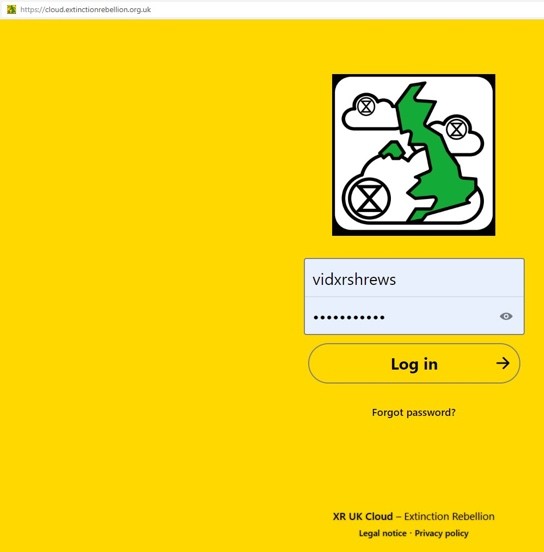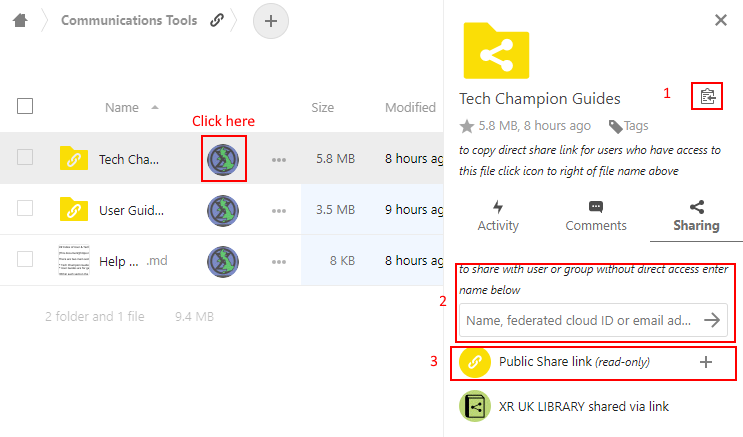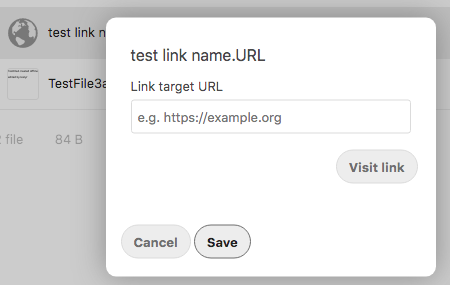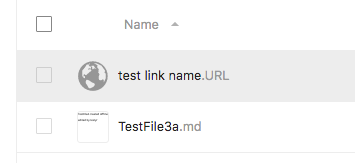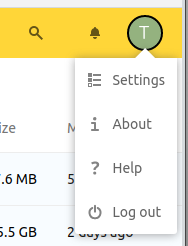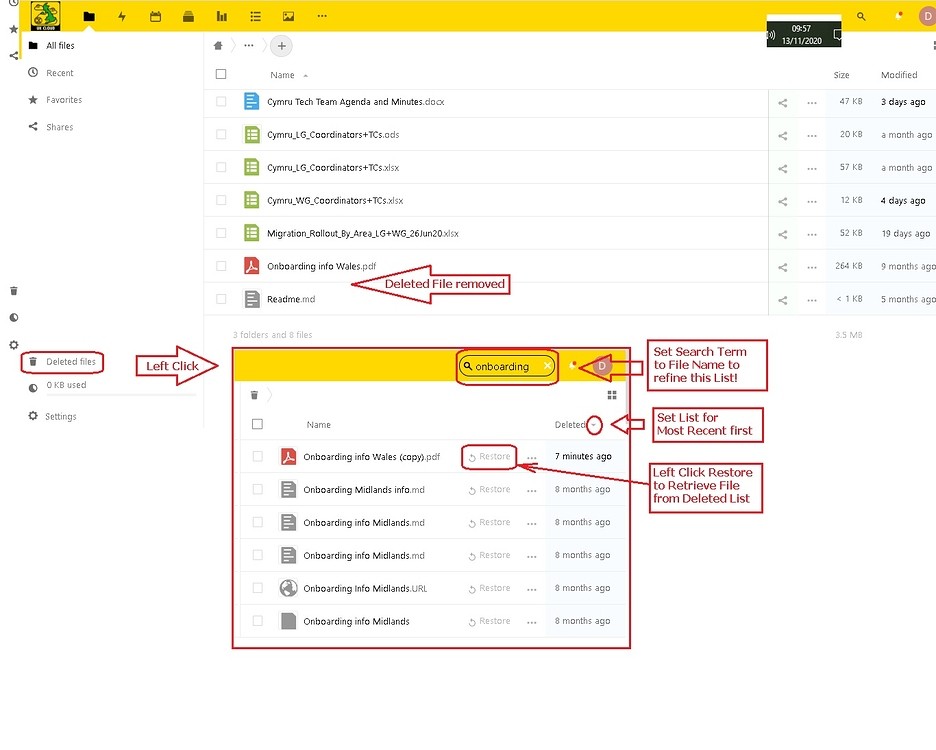Using UK Cloud
Introduction to UK Cloud Storage
UK Cloud Storage is built upon software developed by Nextcloud.com. The application runs on renewable energy powered servers in Switzerland.
Our cloud server address is: https://cloud.extinctionrebellion.org.uk/
How do I access UK Cloud Storage?
There are two main methods for accessing the files held in storage:
-
From your web browser on any device or computer
https://cloud.extinctionrebellion.org.uk -
Using the Nextcloud App on your smart phone or tablet (Android or iOS)
https://nextcloud.com/install/#tab-mobile
or search for "Nextcloud" in your App store
There are also more advanced methods involving "WebDAV" or a desktop client but these are not recommended for UK Cloud as they can cause conflicts when accessing group files.
What facilities does UK Cloud Storage provide?
The primary use of UK Cloud is to store and access files, including uploading, downloading and sharing.
There are built in viewers and editors for some types of file, and there
are additional Apps providing Image Gallery, Calendar, Kanban Project
Management, and Office Document editing (currently disabled owing
to technical problems)
Viewers -- the following file types will open a viewer when you click them:
-
PDF files (.pdf) -- this is the default for most documents in the Library
-
JPG, PNG and some other image files
-
Text files (.txt) -- there is no built in editor for text files, the use of Markdown files is preferred.
If you wish to download a file for which there is a built in editor or view then right-click on the filename and you will see a Download option in the pop-up menu.
For files with no built in viewer or editor clicking the filename directly downloads the file.
Editors -- the following file types will open an editor or can be created by clicking the [+] button (if you have write permissions):
-
Markdown files (.md) -- markdown is a text format with simple formatting. The Markdown editor/viewer allows many people to work simultaneously on the same document and automatically see each other's changes as they happen. Very useful for minutes edited during a meeting.
-
Office files (.docx and .xlsx) -- currently we have had to disable the online collaborative editing of office docs because of technical problems. We hope to have a solution by April 2018.
-
Mindmap files (.km) -- a built in editor to create and manage mindmaps is available by clicking the [+] button or on a .km file name.
Apps -- these are the default extra apps available which create and open their own files:
-
Gallery -- for browsing and viewing multiple image files.
-
Deck -- a Kanban style project management tool. Decks can be shared with others in a group to work collaboratively on a project.
-
Calendar -- a personal calendar which you can share with others and link with your device calendars. Group Coordinators can use this to create a shared group calendar.
How is the file storage organised?
As a user you have no personal storage area. UK Cloud facilities are not to be used for storing or sharing personal files, all files are the property of an XR group.
You will have read/write access to the storage areas for groups you belong to. Within a group's folder (which you will find on your home "All Files" page) any structure that suits the groups can be created.
NB Groups within UK Cloud may cover several groups within an XR Circle -- for example a local group may have all of its working groups' folders within the main local group folder and available to all members of the group. Or a major working group may have its own private folder with sub folders for various teams and projects within the working group.
You will also have read-only access to some common folders -- most of these you will find in the Library shared folder at the top level. There may also be other shared folders and files which have been shared with you by other groups or individuals -- for some of these you might have been granted read/write access.
Although we do our best to keep the data in these tools reasonably secure, you must not post incriminating material of any kind here. By doing so you risk the authorities taking down the server, which would upset our communications severely. Not only would you risk your own arrest, but the arrest of the system administrators, who may be in a country with a repressive justice system.
Navigating UK Cloud Storage
UK Cloud Storage (cloud.extinctionrebellion.org.uk) is where we store our files.
Logging in
Start by logging on to the server. Remember you need to log in to each service -- UK Forum, UK Cloud, Mattermost Chat -- separately. You should have the same username and password on all of them.
With your browser, go to https://cloud.extinctionrebellion.org.uk/
You will find a link direct to UK Cloud on the home page of the Hub -- auth.extinctionrebellion.org.uk
If you are already logged in to UK Forum you will find the cloud icon in the header bar will take you to UK Cloud in a new browser tab
However you get there, enter your username and password to log in to UK Cloud.
If you have previously logged in using the same device and connection, you may find that your login has been remembered and you will arrive straight at the home screen.
Home Screen
The screenshot shows a typical new user's home screen -- the numbered areas are described below:
-
Clicking the logo, the folder icon or the All files entry will normally take you back to this screen
-
Click this icon to show recent activity affecting you -- things you have done and things other people may have shared with you. The left side menu changes to enable you to see various types of activity.
-
This icon is the Gallery app. With it you can browse through folders seeing all of the images in each folder
-
This is your personal Calendar app. You can sync this calendar with your own devices and share it with other users of UK Cloud
-
This icon opens the Kanban Deck project management app.
-
These three icons are external links to the XRUK website, UK Forum and Mattermost Chat. NB these open in the same browser tab, unless you right click and select NewWindow/Tab
-
Click the magnifying glass for a search tool. It will search the filenames of all files you have access to looking for the text you enter. The results appear at the bottom of the screen -- you may need to scroll down to see them.
-
Notifications -- if you have notifications to read a red dot will appear on this icon
-
Your avatar -- click to adjust your personal settings including uploading a visual avatar and to logout.
-
The "Breadcrumbs" area. When you are browsing through folders the path to the current folder will appear here -- click a parent folder to jump back there. If you have file edit rights in the folder a (+) icon will appear to allow you to create or upload a new file or folder, otherwise the message shown in the screengrab above will be shown.
-
This area will show up to 6 files or folders recently edited or shared with you.
-
The folder and file list. Note that for this new user all he can see is the Library folder which is shared (read-only) with everyone, and his local group folder which is where he can create and edit files.
Additional files or folders will appear as they are shared with you or as you join additional groups.
Click on a folder name to open that folder. Click on a filename to open in a viewer (if available) or download. -
If a file is shared with you then you will see the avatar of the person who shared it with you here.
-
Click on the three dots, or right-click on the filename, for options including download, and add to favourites.
-
Click on the light blue area to open the Details Pane for the file which gives you additional information and options.
-
The left Side menu in the Files view gives you additional views including items you have marked as your "Favourites" -- a useful quick way to find folders or files you often need.
FAQs
What is the best way to share a document link with another rebel?
If you know that the user has access to the file - all users can access everything in the Library, and people in your group can access anything under your group folder - then the quickest safe method is to get a "Direct Link"
Find the file in UKCLoud. Don't open it, click towards the right hand end of the row where the file size and date are. This will open the file info pane on the right.
At the top of the Info pane is a thumbnail preview of the file (if one is available) or a file-type icon, under that is the filename and to the right a little icon  .
.
Click the  icon and a link will be copied to your clipboard ready for you to use.
This link will continue to work even if the file is updated, renamed or moved - so long as the person clicking the link has access to the file.
icon and a link will be copied to your clipboard ready for you to use.
This link will continue to work even if the file is updated, renamed or moved - so long as the person clicking the link has access to the file.
If the user doesn't have access to the file then you will need to create a Named Share - see here.
To open the sharing tab for a file or folder, click on the icon on the right of the file name. This may be a sharing icon  , a link icon
, a link icon  or the icon of the person who has shared it with you.
or the icon of the person who has shared it with you.
There are 3 types of sharing on UK Cloud
-
Sharing a link to someone else in your group, or another group that can see the file, so they can find it easily. You do this by clicking on the copy link icon (1 in the screenshot above). That copies the link to your clipboard, from where you can paste it into any program (e.g. here on UK Forum, on Mattermost, or via email). The link will only work for people that already have access to the file or folder on UK Cloud.
-
Sharing with another user or group on UK Cloud You do this by typing the name of the user or group into the box (2 above). When you start typing, a list of names pops down to help you, to make it easier. When you click on one of the names, it creates a share in the list below. The file or folder will appear in the user's (or every user in the group, if you shared to a group) "All files" page as a share. Please don't do this unless the person or group you are sharing with really wants the share - otherwise you will clutter up their All files page with shares they don't want, and have to delete. The default is to share stuff so people can edit it, but you can alter the permissions with the ... menu next to the share.
-
Sharing with everyone on the Internet You do this by clicking the + sign next to Public Share Link (3 above). This creates a public share that anyone on the Internet can use, without having a login on UK Cloud. The share will be listed below, with a clipboard icon so you can copy it to your clipboard, from where you can paste it into any program (e.g. here on UK Forum, on Mattermost, or via email). By default the share will be read only, with an expiration date, but you can change that with the ... menu. Obviously, please don't share any stuff that should not be public, especially including identifying details of people (unless you have their explicit permission in writing). Remember, if you share a folder, people can access everything in the folder and all its subfolders.
We suggest that most shares are done by a "role" login (a login and email that is attached to a role rather than an individual), because if someone leaves UK Cloud, their files and shares may become unavailable.
Obviously the ideal is to move the document from Google Docs to the Library - download it from Google, upload it to your shared Library area, and then delete it from Google Docs.
However it may be desirable to leave the document in Google's care and simply have a link to it in the Library. In this case:
- get a link from Googledocs - with whatever options you require.
- navigate to the folder where you want the link to appear (in your shared library folder if you want all rebels to have it, or in your group folder if it is private to your group)
- click the
 button at the top of the screen and select "New Link"
button at the top of the screen and select "New Link" - Enter the name you want for the link as it will appear in the file list (doesn't have to be the filename, keep it fairly short). Don't delete the ".URL" on the end of the name.
 Press enter or click the arrow.
Press enter or click the arrow. - In the box that pops up after a second or two enter the link URL that you got from google (or any other link you want) and click "Save".
And that's it. Your link will appear in the list of files, with a globe icon to indicate it is an external link.
Why don't we have a document editor?
Our UK Cloud has viewing of most common words processor, spreadsheet and similar documents.
We are working on shared editing of these, but a complete office document editor running on the web is very hard to do. There are two solutions available that claim to be open source, but both have put a limitation of a maximum of 20 editing tabs open altogether, for the whole cloud! This is clearly inadequate, and we have been trying to create a version of one of these products without that limit, but the authors seem to have made it as difficult as possible to do (probably because they would rather we paid them thousands of pounds to do it for us).
Even if we get it working, we don't know how well it will perform with thousands of users.
Alternatives for office documents and spreadsheets
There is a Nextcloud app that will synchronise a folder on your computer with one on the cloud, so you can edit documents locally and the cloud is kept up to date.
It also has a webdav interface, which I believe you can use just like a local folder (though somewhat slower, obviously).
Alternatives for shared editing on the web
You can create a "Text Document" in the cloud, which allows collaborative editing. It's a bit like a Basecamp document - you can format stuff in a limited way, but it doesn't have the features of a full word processor.
There is a Global XR Cryptpad which has shared editing of documents and spreadsheets. You can just use it as a guest, or sign up for a proper login. Once you have created a document on cryptpad, you can add a link to it on the cloud using New Link:
Why don't I have any storage space?
Everyone’s Nextcloud account has 0 bytes of storage in their personal folder. This is for security reasons - if everyone had personal space, there would be nothing to stop someone uploading illegal material to their (fake) account, then reporting it to the police so they raid XR and shut down the servers.
Everyone has access to the read-only Library, and people in an XR group which has requested storage have full read-write access to their group’s storage (where we trust other members of the group would spot suspect files, and remove them).
How does our group get its own folder in the Library?
If your group has relatively static files that you want to share read-only with the entire movement then you need a folder in the Library on UK Cloud.
Everything in the library is visible read-only to all rebels with access to UK Cloud.
Groups can have a folder in the Library area which they can manage themselves - create any subfolders and files you want to share in there. The group library folder can either have full read-write access for all members of the group that owns it, or you might prefer to appoint a librarian(s) from the group to manage it on the group’s behalf.
To get a Library folder for your group simply request one by posting in the Library Reception here on UK Forum - specify who will be managing it for the group (even if all members of your group have write access to it, it is a good idea to have one or two people who are mandated to curate it) and whether all members of the group will be able to create, update and delete files in there.
How to get a Folder in the Library on UK Cloud (For a Working Group)
First , for clarity , this would be in addition to the WG's own private folder and would be used to "publish" information that will be accessible to anyone with an account on UK Cloud. ....
If your organisation is likely to produce documents to publish to the whole of XRUK or to curate resources for the whole of XRUK then you can request a Library area for your organisation. At present this is done by contacting the Librarians directly through their Reception Forum on UK Forums or through their Reception Channel in the UK Team on Mattermost.
If your organisation does wish to have Library space in addition to their own private space, then they need to be aware that they will be completely responsible for what is published there. It would be a good idea to identify one or two individuals who will act as librarians for the organisation and manage the organisation’s folder. If the group is producing a lot of material, then it would be sensible for at least one person to join the Librarian’s work group.
When you request a Library area for your organisation, the Librarians will create a new folder in the Library and share it back as an editable (read-write-create-delete) area.
If you wish to have the organisation’s Library folder curated by one or two named individuals, then let the Librarians know and the folder will be share as editable only with them. Other members of the organisation will be able to find it in the normal way through the Library shared folder.
If the organisation does not have willing help to curate their area, then the editable share will be made with the whole group and all members of the group will be able to copy or move files to the folder and edit what is there – including creating sub-folders etc.
For a small working group where all members are active and know what they are doing this probably makes sense.
For a larger diverse group, such as a local or regional group, then it makes more sense to have a few individuals able to manage their Library area. If the area is open to all your members then it becomes very easy for people to make mistakes and create or delete material in error.
How to change the order of the header icons
In the browser view of UK Cloud there is a row of icons at the left hand end of the yellow header bar.
These link to the internal cloud apps (files, polls, forms etc) and some external websites.
As the screen width is reduced the icons flip from the right into a three dots drop-down menu.
The default order of the icons is: Files | Activity | Calendar | Deck | Polls | Forms | Photos | UK Hub | UK Forum | Chat | UK Website
You can customise the order to suit your requirements. Here's how:
- Click on your Avatar in the top right of the header and select "Settings"
- In the left hand pane select "App Order" (probably at the bottom of the list of setting options) . Un check any you don't want displayed (and remember that you have done that in case you ever want to get to them again!) and drag the remaining ones into the order you want.
Click away to something else and your ordering will be saved.
- If you want to find that Deleted File, click 'Deleted Files', bottom left of UK Cloud screen, and search the resulting Deleted Files List for the lost File.
- You may have to put the File Name into Search to help, as the Deleted File List may be long.
- Also, if it is a recently deleted File, then ensure the List displays Recent First (toggle the up/down arrow).
- Find the File, click 'Restore' and the File will be returned to its Folder - Simples.
Here's a graphic:


